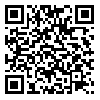Volume 12, Issue 4 (12-2022)
J Health Saf Work 2022, 12(4): 784-799 |
Back to browse issues page
Download citation:
BibTeX | RIS | EndNote | Medlars | ProCite | Reference Manager | RefWorks
Send citation to:



BibTeX | RIS | EndNote | Medlars | ProCite | Reference Manager | RefWorks
Send citation to:
Ghasemi F, Nourian S, Babamiri M. The Psychometric Properties of the Persian Version of the Affinity for Technology Interaction (ATI) Scale. J Health Saf Work 2022; 12 (4) :784-799
URL: http://jhsw.tums.ac.ir/article-1-6771-en.html
URL: http://jhsw.tums.ac.ir/article-1-6771-en.html
1- Department of Occupational Health and Safety Engineering, Abadan University of Medical Sciences, Abadan, Iran
2- Human Factors Engineering, Chair of Ergonomics, Technical University of Munich, Munich, Germany
3- Department of Ergonomics, Research Center for Health Sciences, School of Public Health, Hamadan University of Medical Sciences, Hamadan, Iran ,mohammad.babamiri@yahoo.com
2- Human Factors Engineering, Chair of Ergonomics, Technical University of Munich, Munich, Germany
3- Department of Ergonomics, Research Center for Health Sciences, School of Public Health, Hamadan University of Medical Sciences, Hamadan, Iran ,
Abstract: (999 Views)
Introduction: Affinity for Technology Interaction (ATI) refers to the users’ tendency to actively interact with a digital system. ATI is a personal characteristic affecting many aspects of human-technology interaction. The present study aimed to assess the psychometric properties of the Persian version of the ATI scale.
Material and Methods: The Persian version of the scale was developed in accordance with the forward-backward translation approach. The construct validity of the scale was assessed using exploratory and confirmatory factor analyses. The correlation of the scale with the Big-five personality traits, need for cognition (NFC), age, gender, and field of study was also investigated.
Results: In contrast to the original scale, the Persian ATI had two components, confirmed by the exploratory and confirmatory factor analyses. The first component contained eight items and the second contained one item, item 3. So, this item was removed from the scale. The 8-item scale demonstrated excellent reliability (coefficient=0.90). The Persian ATI was not significantly correlated with extraversion, agreeableness, conscientiousness, and neuroticism (p>0.05). In contrast, it was significantly correlated with openness to experience (0.175, p<0.01) and NFC (0.36, p<0.01). The Persian ATI score for men was higher than for women. Various age groups were not significantly different in terms of the Persian ATI score.
Conclusion: In contrast to the original version, the Persian version of ATI is composed of eight items. Other characteristics, including unidimensionality and correlation with other personality traits, are similar to the original version.
Material and Methods: The Persian version of the scale was developed in accordance with the forward-backward translation approach. The construct validity of the scale was assessed using exploratory and confirmatory factor analyses. The correlation of the scale with the Big-five personality traits, need for cognition (NFC), age, gender, and field of study was also investigated.
Results: In contrast to the original scale, the Persian ATI had two components, confirmed by the exploratory and confirmatory factor analyses. The first component contained eight items and the second contained one item, item 3. So, this item was removed from the scale. The 8-item scale demonstrated excellent reliability (coefficient=0.90). The Persian ATI was not significantly correlated with extraversion, agreeableness, conscientiousness, and neuroticism (p>0.05). In contrast, it was significantly correlated with openness to experience (0.175, p<0.01) and NFC (0.36, p<0.01). The Persian ATI score for men was higher than for women. Various age groups were not significantly different in terms of the Persian ATI score.
Conclusion: In contrast to the original version, the Persian version of ATI is composed of eight items. Other characteristics, including unidimensionality and correlation with other personality traits, are similar to the original version.
Type of Study: Research |
Received: 2022/12/26 | Accepted: 2022/12/31 | Published: 2022/12/31
Received: 2022/12/26 | Accepted: 2022/12/31 | Published: 2022/12/31
Send email to the article author
| Rights and permissions | |
 |
This work is licensed under a Creative Commons Attribution-NonCommercial 4.0 International License. |







